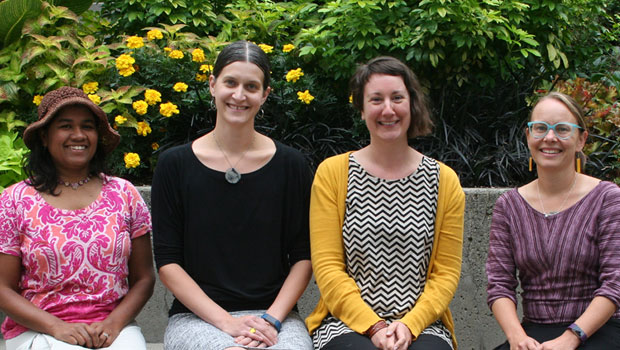Can kids be screened routinely for adverse childhood experiences?

Elena Kuo, PhD, MPH, Maggie Jones, MPH, Creagh Miller, MPH, Lisa Schafer, MPH
Lisa Schafer leads CCHE’s evaluation of the Center for Youth Wellness’ National Pediatric Practice Community on ACEs Screening
by Lisa Schafer, MPH, Senior Research Associate/Program Manager at Kaiser Permanente Washington Health Research Institute’s Center for Community Health and Evaluation
In public health, we believe that our environments and experiences shape our health in significant ways. We know that what happens to us in childhood matters. That’s just one reason why I’m delighted to be leading the evaluation of the National Pediatric Practice Community on Adverse Childhood Experiences (ACEs) Screening for the Center for Youth Wellness (CYW) in San Francisco.
Dr. Nadine Burke Harris founded the CYW. You can watch her TEDMED talk here: “How Childhood Trauma Affects Health Across a Lifetime.” In her talk, she describes how the consequences of ACEs are often misdiagnosed as attention deficit hyperactivity disorder. She pleads with pediatricians to confront the prevention and treatment of ACEs and toxic stress using routine screening for ACEs and trauma-informed care by a multidisciplinary team.
What are ACEs?
Dr. Burke Harris describes how seven of the 10 leading causes of death can be worsened — and lives cut short — in adults who had these ACEs as children:
- Physical or emotional or sexual abuse;
- Physical or emotional neglect;
- Parental mental illness, substance dependence, or incarceration;
- Parental divorce or separation; or
- Domestic violence.
ACEs are very common, with 2 in 3 people having at least 1 ACE and 1 in 8 people having 4 or more ACEs. Studies have shown a dose-response relationship between ACEs and poor health outcomes, early death, and higher death rates.
Yet many health care providers don’t screen routinely for ACEs. That’s why the CYW launched the National Pediatric Practice Community on ACEs Screening. This Practice Community aims to build the capacity of pediatric and family health providers to screen routinely for ACEs, understand and measure the scope of childhood trauma, and provide appropriate supports and follow-up to patients. Over 3 years, the program has the goal of supporting 1,000 pediatric medical providers in making ACEs screening and intervention part of their routine clinical practice.
Three-part evaluation
We’re evaluating the program to document progress and better understand facilitators and barriers to for providers implementing ACEs screening. Our evaluation has three components, which we’re working on in parallel:
- Dr. Elena Kuo is doing a retrospective analysis that will help to inform the Practice Community. She is analyzing data from California Pacific Medical Center’s Bayview Child Health Center and CYW, both in San Francisco. Bayview refers patients to CYW for resources and services including mental health, social work, and integrative interventions such as biofeedback. She is reviewing two years of screening for ACEs at Bayview, linked to data from CYW to understand patterns of treatment usage and outcomes for youth who screen positive for ACEs.
- Creagh Miller and I are evaluating the national, virtual learning community. The program is designed to meet practices and providers (including pediatricians and nurse practitioners) wherever they are in their process toward ACEs screening. Participants receive information and resources, tools, and trainings to build awareness and understanding and facilitate practice change. We’re currently collecting baseline data on participants related to their current knowledge and practice regarding screening for ACEs.
- We’ll also evaluate a year-long pilot program in four to six disparate sites (including sites in New York, Los Angeles, and San Francisco) that aren’t screening for ACEs but want to do so. They’ll receive a practice coach for implementation support and change management.
The biggest challenge
We look forward to learning a lot more, but so far we can say that the biggest challenge is convincing providers to screen for something that they may not know how to treat themselves or have places to easily refer. Ideally, follow-up depends on a child’s symptom level and number of ACEs:
- ACE score 0–3 with no clinical symptoms: anticipatory guidance;
- ACE score 0–3 with clinical symptoms or 4 or more: refer to appropriate treatment.
Providers may need to change their practices to provide support and interventions including mental health services and social work. They may also need help with identifying potential supports or services to refer patients.
Yet Dr. Burke Harris suggests that screening for ACEs can serve as a kind of intervention, because families appreciate that providers are paying attention and asking.
Coming full-circle
It’s a full-circle journey for us at KPWHRI’s Center for Community Health and Evaluation, because recognition of the dire long-term effects of adversity and toxic stress in childhood all started with Kaiser Permanente. Two decades ago, Dr. Vincent Felitti of Kaiser Permanente published the seminal “Relationship of Childhood Abuse and Household Dysfunction to Many of the Leading Causes of Death in Adults” with Dr. Robert Anda of the Centers for Disease Control and Prevention and other ACE study colleagues.
Over the years, understanding of the impact of ACEs has deepened. It’s an exciting time to be doing this work, because ACEs seem to be reaching a tipping point where more and more people have heard of them — and are doing something about them to promote resilience.
Learn more about Kaiser Permanente Washington Health Research Institute. Sign up for our free monthly newsletter.


